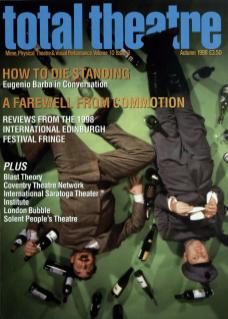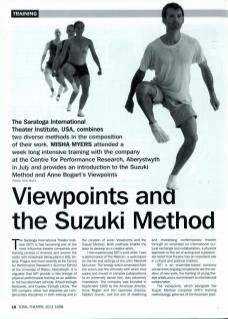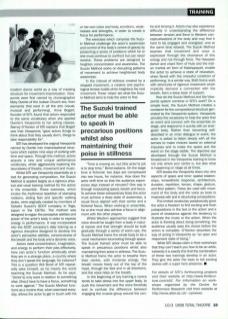The Saratoga International Theater Institute (SITI) is fast becoming one of the most influential theatre companies and training centres in America and around the world, with workshops taking place in Italy, Ireland, Prague and most recently at the Centre for Performance Research's Summer School at the University of Wales, Aberystwyth. It is arguable that SITI provide a new lineage of physical performance training as an addition to the two dominant schools: Artaud through Grotowski, and Copeau through Lecoq. The SITI company utilise two disparate yet complimentary disciplines in both training and in the creation of work: Viewpoints and the Suzuki Method. Both methods enable the actor to develop as a creative artist.
I first experienced SITI's work when I saw a performance of The Medium, a work based on the life and writings of the critic Marshall McLuhan. The energy which emanated from the actors, and the virtuosity with which they spoke and moved in complex juxtapositions to an extremely dense text, was extremely impressive. The company was founded in September 1992 by the American director Anne Bogart and the Japanese director Tadashi Suzuki, with the aim of redefining and revitalising contemporary theatre through an emphasis on international cultural exchange and collaboration, a physical approach to the art of acting and a passionate belief that theatre has an important role in cultural and political matters.
SITI is an ensemble-based company whose three ongoing components are the creation of new work, the training of young theatre artists, and a commitment to international collaboration.
The Viewpoints, which alongside the Suzuki Method comprise SITI's training methodology, grew out of the American postmodern dance world as a way of creating structure for movement improvisation. Viewpoints were first named by choreographer Mary Overlie of the Judson Church era, from elements that exist in all the arts (visual, musical and performing). Anne Bogart, founder of SITI, found that actors responded to the same vocabulary when she applied Overlie's Viewpoints to her acting classes. Barney O'Hanlon of SITI explains that Bogart saw that Viewpoints ‘gave actors things to think about that they usually don't, things to take responsibility for’.
SITI has developed the original Viewpoints named by Overlie into improvisational structures which explore nine ways of working with time and space. Through this method, actors acquire a new and unique performance vocabulary, whilst aggressively exploring the boundaries of theatre, movement and music.
Whilst SITI use Viewpoints essentially as a tool for generating composition, the Suzuki Method is applied largely as a rigorous physical and vocal training method for the actors in the ensemble. These exercises, which involve the rhythmical repetition of stamping motions, sliding feet, and specific walking styles, were originally created by members of Tadashi Suzuki's SCOT company in Toga, Japan in the 1970s. The method was designed to regain the perceptive abilities and power of the actor's body in order to express energy in performance. It was incorporated into the SCOT company's daily training as a rigorous discipline designed to develop the actor's perceptive abilities, consciousness of the breath and the body and a dynamic voice.
Actors need concentration, imagination, and energy to perform their jobs effectively. How can actors function artistically when they are in a strange place, a country where they don't speak the language, for instance? This is a question Will Bond of SITI repeatedly asks himself, as he travels the world teaching the Suzuki Method. As he says: ‘[Actors] only exist in relation to something else; [they] have to have a focus, something to work against.’ The Suzuki Method functions as a routine that, when exercised every day, allows the actor to get in touch with his or her own voice and body, emotions, weaknesses and strengths, in order to create a focus for performance.
The exercises which comprise the Suzuki Method challenge the actor's awareness and control of the body's centre of gravity by presenting a series of problems which he or she must continue to confront but can never resolve. These problems are designed to heighten concentration and awareness. The Suzuki Method works on disrupting patterns of movement to achieve heightened body awareness.
In the interval of stillness created by a stopped movement, a creative and psychological tension builds which heightens the next movement. These 'stops' are what the Suzuki Method aims to help the actor to find.
The Suzuki-trained actor must be able to speak in precarious positions whilst also maintaining their poise in stillness.
‘Time is moving on, but [the actor's] job is to stop time,’ Bond explains. On the stage time is fictional; two days are compressed into two hours, for instance. How does the actor shift time so that the audience experiences days instead of minutes? One way is through modulating speed, breath and focus. To achieve these extraordinary feats the actor must achieve a deep state of awareness, a visual focus aligned with their centre and a fictional focus. When working in ensemble, he or she must also achieve a focus in alignment with the other players.
Whilst Western approaches suggest that voice should be taught from a body in natural repose and that strength should be built gradually through a series of warm-ups, the Suzuki Method trains the whole body to be a vocal mechanism locomoting through space. The Suzuki-trained actor must be able to speak in precarious positions whilst also maintaining their poise in stillness. The Suzuki Method trains the actor to breathe from their centre, with immense energy. The breath moves freely out of the top of the head, through the feet and in all directions, and the voice rides on the breath.
In the beginning of any training a novice tends to take stress into the upper body, to push the movement and the voice forcefully and to confuse the difference between engaging the muscle group around the centre and tensing it. Actors may also experience difficulty in understanding the difference between tension and force in Western conceptualisations of the body and may find it hard to be engaged and energised, and at the same time relaxed. The Suzuki Method teaches that movement and voice is expressed through the resonance of this energy and not through force. The Hawaiian dance and chant form of Hula and the Indian martial art form of Kalarippayatt, enable the actor to achieve a state of relaxation, when faced with the stressful condition of performing, in a similar way. Both forms work with structures of rigorous movement which implicitly demand a connection with the breath, from a deep base of support.
How do the Suzuki Method and the Viewpoints system combine in SITI's work? On a simple level, the Suzuki Method creates a container for the compositional structure generated by the Viewpoints system. Viewpoints provides the vocabulary to help the actor find an event and connect with the ensemble on stage, and respond to it quickly with an energised body. Rather than becoming self-absorbed in an inner dialogue or event, the actor is asked to listen deeply with all the senses to make choices based on external impulses and to make the space and the event on the stage visible. The objective eye developed through the Suzuki Method is broadened in the Viewpoints training to know not only where your centre is, but also what is happening on stage at all times.
SITI breaks the Viewpoints down into nine aspects of space and time: spatial relationships, kinaesthetic response, architecture, duration, repetition, tempo, shape, gesture, and floor pattern. These are used with movement of the body and the voice as tools to improvise with and in structuring compositions.
This limited vocabulary paradoxically gives the actor a freedom to find exciting and fresh juxtapositions in the text or the action and a point of resistance against the tendency to illustrate the music or the action. When the actor is thinking about doing something the audience usually sees the choice before the action is complete. O'Hanlon describes the way of acting in Viewpoints as ‘an open and responsive state of being’.
While SITI always claim in their workshops that they can't teach you how to be an artist, indirectly it is exactly this that the combination of these two trainings develop in an actor. They give the actor the tools to tell exciting stories with a super hero presence.
For details of SITI's forthcoming projects visit their website at http://www.thirdculture.com/sitil For information on workshops organised by the Centre for Performace Research visit their website at http://www.aber.ac.uk/-cprwww


